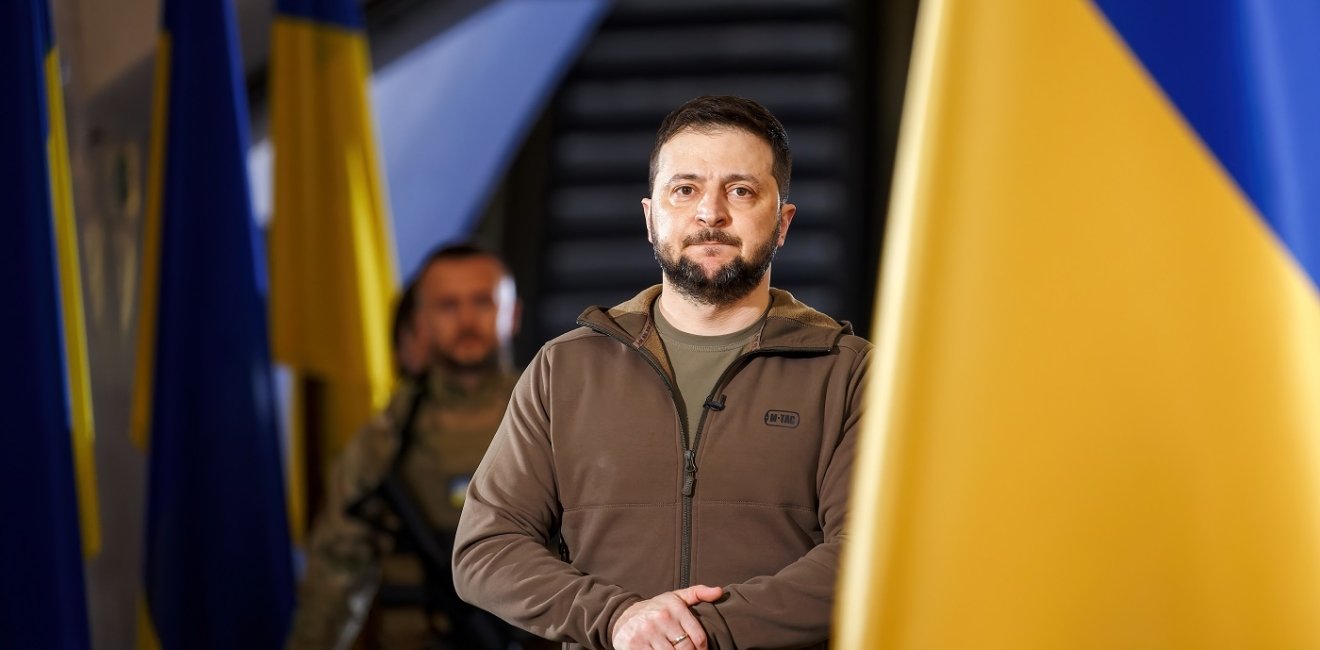
A blog of the Kennan Institute
BY MYKHAILO MINAKOV
Public governance and politics in Ukraine changed profoundly after Russia’s full-throated invasion of Ukraine beginning February 24, 2022. June 3 marked the hundredth day of what can be called Ukraine’s new administration—though the people in government have not changed. What has been held over from the “old” administration, prior to the invasion, and what new directions for the administration have emerged? As the below assessment shows, today’s situation is dauntingly complex for President Volodymyr Zelensky to negotiate, with the revival of domestic political conflicts adding to the burdens of a wartime presidency.
The First Age of Zelensky’s Administration: 2019–2020
Zelensky came to power in the spring of 2019 with a mandate from 73 percent of voters—rich and poor, urban and rural dwellers, Ukrainian and Russian speakers—across all regions of Ukraine. At the same time, the older generation of Ukrainian politicians, as well as the Western and Eastern political establishments, regarded him with some concern and even suspicion: a humorist and showman with no prior experience in public administration, what Zelensky might do once in office was unpredictable. The new president was not a professional politician, his team included no known diplomats and activists, and his platform was both vague and heavily populist.
During his first hundred days, however, the newcomer to politics won early parliamentary elections and established a one-party-majority in the Verkhovna Rada—something that none of Ukraine’s previous presidents had enjoyed. It is perhaps a mark of Ukrainian voters’ intense desire for change that they gave Zelensky and his party, Servant of the People, a generous mandate, amounting almost to carte blanche, to fix some adamantine problems and set Ukraine firmly on a westward orientation.
The program of Zelensky and his team was perhaps deliberately nonspecific, leaving it up to the voters, frustrated by the divisive rule of former president Petro Poroshenko (2014–2019) and its taint of corruption, to vest their hopes for the future in a person who had no connection to the Ukrainian political class.
Zelensky and his team of “new faces”—politicians of the generation that had grown up during the era of independence and who were not connected to the old ways of getting things done, which too often involved cronyism and deal-making—were tasked by voters to achieve three goals: (1) peace in the Donbas, (2) economic betterment for ordinary Ukrainians, and (3) a noncorrupt and responsive government.
In 2019–2020 Zelensky’s team put forth an enormous effort to address the first and most important requisite, resolving the situation in the Donbas.
The December 9, 2019, meeting in Paris of President Zelensky with his counterparts from Germany, France, and Russia offered some prospect for peace. By August 2020 the level of shelling on the front lines of the temporarily occupied territories had considerably fallen, several POW swaps with Russians and the separatists controlling those territories had taken place, and a partial pull-back of troops had some circumscribed success. Zelensky’s team in the presidential office and his supporters in parliament and the first cabinet launched a number of reforms aimed at economic growth, good governance, and responsive politics.
However, the lack of experience, public scandals, relentless conflicts with older politicians and oligarchs, and the COVID-19 pandemic forced Zelensky to change his policies and slow the pace of reforms.
The Turn to Security: 2020–2021
The temptations of Ukrainian Realpolitik, the weak parliamentary opposition (which provided almost unlimited opportunities for the president to get his way), snowballing socioeconomic problems, worsened by the COVID-19 pandemic, and the never-ending conflict in the Donbas led to changes in the administration’s policies and behavior in the fall of 2020. A new President Zelensky, very different from the 2019 version—more strategic in dealing with political forces, firmer in decision-making, and clearer in his drive for power—began to emerge.
The strategic maneuvering now aimed at new projects that had little connection with Zelensky’s hazy electoral promises. Informally, the principal decision-making role moved to the National Security and Defense Council of Ukraine beginning in October 2020. President Zelensky and the senior members of his team began running major decisions on issues of domestic politics, international relations, and security matters through this body, in lieu of trying to get resolutions passed by parliament, then legally enforcing those decisions through presidential decree. Even though formally Ukraine remained a parliamentary-presidential republic, the real role of the Verkhovna Rada and the cabinet was informally redefined as supporting the presidential core.
Thus freed from the need to gain consensus in the Rada and the cabinet, Zelensky’s administration with its reshaped powers could focus more on countering the harsh socioeconomic consequences of the COVID-19 pandemic, which the opposition was using to lambast the president and try to sink his popularity ratings.
The “Big Construction” project was designed to rebuild the ageing public infrastructure and prepare Ukraine for a fast post-COVID recovery. New and daring counteroligarchic laws were passed, and policies were put in place that were intended to ensure that the recovery would increase the president’s and the Security Council’s authority and not be diverted by the clans for their own purposes. The president’s powers were constantly increasing, and, despite an expected decline in his popularity rating, Zelensky remained the most popular among Ukraine’s most prominent politicians, especially those with presidential ambitions.
President Zelensky and his team also redefined their foreign policy, returning to and even honing former president Petro Poroshenko’s pro-Western policies.
In 2021 Zelensky’s administration had three priorities. First, as conflict with Russia was only increasing, the administration restored the issue of annexed Crimea to the center of Ukraine’s foreign policy. The Crimean Platform, a new international forum launched in August 2021 to counter Russia’s claims to Crimea and insist on the rule of law, has partially fulfilled this task, and there was a notable uptick in Western democracies’ public support for Ukraine in the conflict with Russia.
The second and third tasks were to ensure Ukraine’s fast integration with the EU and with NATO. On these tasks, the results were rather meager: neither organization opened its doors to Ukraine’s membership in 2021, which led to more direct criticism on Zelensky’s part of the “hypocritical West” and an equally unpromising response from the organizations’ chiefs.
All these domestic and foreign policy endeavors were conducted in the face of an increasing threat from Russia to launch a new and much more severe attack on Ukraine.
The Wartime President: 2022
The Russian-Ukrainian war actually started in 2014 when Crimea was annexed and the Donbas separatists and irredentists were militarily, politically, and economically supported by the Russian Federation. On February 24, 2022, Russian and separatist army units attacked Ukraine on a large scale—from the north, east, and south. Since that day we have seen a new, third version of President Zelensky—and the third version of his administration.
With the launch of the invasion, Zelensky’s number one priority became the defense of Ukraine by all possible—and seemingly impossible—means. Zelensky demonstrated courage and dedication to Ukraine’s resistance during the worst initial days of the war. His presence in Kyiv and his guidance of the defense campaign encouraged Ukrainians in all regions and all walks of life to come together in national unity and in the practice of resilience. His digital omnipresence in Ukrainian homes and in Western public spaces created the effect of (almost global) confidence in himself and an unprecedented solidarity with Ukraine.
In February and March 2022, the Zelensky administration sought to distribute arms to as many fighters as possible. Economic policies were recalibrated to help households and companies to survive, while the social obligations of the government were upheld. In those days the government worked round the clock to stave off Russian advances, cement international support for Ukraine, and help the population survive—all of which resulted in Ukrainian forces winning the battles for Kyiv and northern Ukraine.
Since April, however, the Zelensky administration has adapted to the war situation and endorsed a multidimensional approach, simultaneously pursuing many tasks, some more politically focused than others.
The president’s team has continued working on immediate war-related issues, in particular gaining increased military, political, humanitarian, and financial support from the United States, the EU, and NATO. But the Zelensky administration has also started undertaking actions to prepare the country for a longer war of attrition—and for the future reconstruction of Ukraine. President Zelensky’s vow to hold the 2023 Eurovision contest in Ukraine is a daring vote of confidence in Ukraine’s tomorrow.
As the conflict turns ever more somber in southern Ukraine and the Donbas, however, the Zelensky administration faces increasing challenges, both on the national defense front, especially in eastern Ukraine, and on the political front.
Despite the defensive forces’ earlier successes in Kyiv, Chernihiv, and Kharkiv, the failed defense of Mariupol and Severodonetsk has breathed new life into prewar political controversies. The Petro Poroshenko-led opposition has used the military situation in the Donbas to launch attacks on the president and his war strategy (Poroshenko took only 24 percent of the vote in the 2019 presidential elections and seems clearly intent on returning to power).
In what can be read as an administration-directed response, Ukraine’s Security Service, the SBU, resumed questioning of the detained pro-Russian oligarch, Viktor Medvedchuk, who offered new testimony against Poroshenko regarding the former president’s deals with Russia. The SBU also summoned Oleksandr Turchynov, former high-ranking politician in the Poroshenko administration, and Arseniy Yatsenyuk, former prime minister under Poroshenko, for questioning on the related allegations of Poroshenko arranging illegal sales of coal mined in the Donbas, with cash paid to the separatists.
The first hundred days of war are about to conclude, and the familiar political bickering and attacks seem to have returned to Kyiv.
The opinions expressed in this article are those solely of the authors and do not reflect the views of the Kennan Institute.
Author


Kennan Institute
After more than 50 years as a vital part of the Wilson Center legacy, the Kennan Institute has become an independent think tank. You can find the current website for the Kennan Institute at kennaninstitute.org. Please look for future announcements about partnership activities between the Wilson Center and the Kennan Institute at Wilson Center Press Room. The Kennan Institute is the premier US center for advanced research on Eurasia and the oldest and largest regional program at the Woodrow Wilson International Center for Scholars. The Kennan Institute is committed to improving American understanding of Russia, Ukraine, Central Asia, the South Caucasus, and the surrounding region through research and exchange. Read more

Explore More in Focus Ukraine
Browse Focus Ukraine
Talking to the Dead to Heal the Living

Ukrainian Issue in Polish Elections


